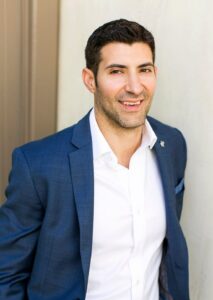An Interview With Fotis Georgiadis
Collaboration is a growing theme everyone is talking about now. There is an often used saying that it’s lonely in VR. The reason is that once you put on a VR headset, you see and feel the immersive surroundings and are mentally in a different place and state of mind. But the other people around you who are not wearing the headset don’t feel it and don’t see it. With mixed reality, we allow people to see each other while experiencing virtual content. A lot of creative work and decision-making is about collaboration — and bringing the technological tools for people to share and experience things together virtually, in photorealistic 3D, is a huge opportunity.
The Virtual Reality, Augmented Reality & Mixed Reality Industries are so exciting. What is coming around the corner? How will these improve our lives? What are the concerns we should keep an eye out for? Aside from entertainment, how can VR or AR help work or other parts of life? To address this, as a part of our interview series called “Women Leading The VR, AR & Mixed Reality Industries”, we had the pleasure of interviewing Varjo’s Anna Nilsson.
Anna Nilsson is at the forefront of user-centered design, with decades of experience bringing emerging technologies to life. As the Head of Design and Research at mixed reality hardware and software maker, Varjo, Anna leads the team that is creating and designing the future of immersive technologies. She has been instrumental in growing Varjo’s design and research capabilities and developing three generations of the highest-end XR devices to meet the needs of Varjo’s professional customers, including the likes of Boeing, Volvo, Siemens, and Aston Martin.
Using research data and end-user understanding to inform product planning, Anna is right now working on transforming Varjo’s hardware-driven offering to immersive software and services. She is also an experienced team leader, adept at coaching diverse teams to work and design in new realities that are not bound by the laws of physics.
Thank you so much for doing this with us! Before we dig in, our readers would like to get to know you a bit. Can you tell us a bit about your backstory and how you grew up?
Thank you for inviting me!
I was born and raised in Helsinki, Finland in an entrepreneurial family. Growing up my passion was music and performing arts, and I was a heavy consumer of literature. I played several instruments throughout my school years, both folk and classical music, and later in university years, I also took classical singing classes. Surprisingly, a career in technology wasn’t an obvious choice for me, even though I always liked to understand how the world functions and operates. I developed an interest in human behavior early on, and by the time I entered high school, I had borrowed and read all high school psychology books from the local library. While many of my friends with music hobbies dreamed about a music career, I enjoyed prepping for my final exams in physics and math.
My choice of university was actually a bit of a lucky coincidence. In the year of my high school matriculations and around the time of the dot-com wave, Helsinki University of Technology had founded a cross-discipline master’s program called Information Networks, which aimed to combine studies in technology, business, and social sciences. Their objective for the curriculum was to prepare students for the new millennium, which would require new types of talent with sensitivity to navigate all these domains when creating new technology. I became one of the first students in their degree program and graduated as Master of Science in Technology five years later.
Is there a particular story that inspired you to pursue a career in the XR Reality industry? We’d love to hear it.
Before joining Varjo, I had already developed a career as a user-centered designer and user researcher in both consultancies and in-house R&D roles in some of Finland’s most established companies. When the opportunity to join Varjo opened, I was willing to pursue something more agile. Back then, Varjo was only just developing their first headset, and there were only a few tech vision demos to show. But I was instantly blown away by the possibilities. In addition to being able to produce an immersive, true-to-life presentation of a space, Varjo’s mixed reality technology would make it possible to control everything we capture from the real world and edit it to alter the reality — add and remove objects, change the lights, shrink, and stretch things as we liked. “It’s just pixels,” the team explained to me. While the thought of this made my brain hurt a bit, I felt compelled to see what this technology could do for businesses around the world.
Virtual reality is not really a new thing. In fact, 20 years ago university literature was full of academic articles and buzz about how VR could one day change the way we work, learn, and interact. Visiting Varjo’s small offices in midtown Helsinki on that day in early 2018, I felt what I am seeing was not a science fiction experimentation anymore — it’s actually real and possible today, and I knew I wanted to be part of creating that new reality.
Can you share the most interesting story that happened to you since you began this fascinating career?
My work as user researcher has led me to places that I wouldn’t have visited otherwise. I’ve led research projects on four different continents and visited private homes and corporate high-security areas. It is a bit of a cliché, but it never stops amazing me how meeting and seeing users in their real context and everyday settings helps us as designers think about our creations from a new perspective.
Can you share a story about the funniest mistake you made when you were first starting? Can you tell us what lesson you learned from that?
This seems to be a question that is asked often, particularly of people who have made progress in their career. I think maybe this is so often asked because people want to hear that leaders are also human and make mistakes.
To be honest, I have a mixed relationship with the word ‘mistake’. I don’t actually believe there is such a thing when creating something new. (Of course, there may be pure misconduct or negligence, but that’s another thing and there’s nothing funny about it.) The way I see it, there may be things we don’t know at the time and that can lead us to make wrong choices, overestimate or underestimate, or there may be signals and feedback we interpreted incorrectly because we didn’t understand what we were seeing and hearing. I’ve experienced that with several projects in my career, and there have been times we’ve had to reset or start a whole project over once we gathered more learnings and understood what we were building needed to change. For me, this is at the core of our work that we do here every day.
Personally, and professionally, when looking back at myself taking my first steps in design and research, there are a lot of incidents that make me smile now years later. I was often too straightforward and too fast to form an opinion. The capability to navigate and make progress, even when there are a lot of things undecided, unpolished, and unfinished is something that takes time to learn and accept. Today, that is one of the things I enjoy most in my work.
Ok super. Thank you for all that. Let’s now shift to the main focus of our interview. The VR, AR and MR industries seem so exciting right now. What are the things that most excite you about the industry? Can you explain or give an example?
To start with, we at Varjo have seen high-end mixed reality as a tool and enabler of new workflows for business. While the VR scene is still very much driven by gaming and entertainment, mixed reality applications — where the real world can blend with virtual content, and vice versa — are very much used and developed for productivity purposes.
As a designer, I find the creative opportunities of mixed reality enormous, especially for designing physical objects such as vehicles, furniture, or architecture. Instead of designing on 2D screens, being able to observe and feel the scale in the real-world context is super-important and helps determine what the final outcome will be like.
Second, collaboration is a growing theme everyone is talking about now. There is an often used saying that it’s lonely in VR. The reason is that once you put on a VR headset, you see and feel the immersive surroundings and are mentally in a different place and state of mind. But the other people around you who are not wearing the headset don’t feel it and don’t see it. With mixed reality, we allow people to see each other while experiencing virtual content. A lot of creative work and decision-making is about collaboration — and bringing the technological tools for people to share and experience things together virtually, in photorealistic 3D, is a huge opportunity.
At Varjo, we are taking that one step further with what we call virtual teleportation. We are developing technology that will allow users to teleport to any real-world location with others, making their actual physical location completely irrelevant. In our vision, teleportation is not just a simple hologram of an environment or a static 360° image; we’re talking about a fully immersive, real-time presence allowing users to collaborate in ways that haven’t been possible before.
This is what I feel has potential to change the way we work faster than any other technology available right now.
What are the 3 things that concern you about the VR, AR and MR industries? Can you explain? What can be done to address those concerns?
The concerns around VR revolve very much around the same themes as in digitalization and IT services, but on a broader scale. Corporate data security, protection of personal data and identities — these are issues that all companies who care for their customers take very seriously.
VR and mixed reality bring yet another layer on top of all that — psychological safety and social inclusion. How should people behave and treat each other in these new immersive, social settings? There are rules for what’s acceptable conduct in the real world, and we need to translate those habits into the virtual worlds. Topics I am working on daily address the questions of how people are represented in virtual settings, and how we support and enforce equality in VR.
VR can allow people to go to places they can’t physically reach, whether it’s due to geographical and physical constraints or disabilities. We have a great opportunity to use the technology to build a more equal and accessible world for us all.
I think the entertainment aspects of VR, AR and MR are apparent. Can you share with our readers how these industries can help us at work?
Virtual and mixed reality have tremendous potential for education and training. For example, I am personally one of those people who learn by doing. Trying with my own hands, being there in the situation or space myself, has a way of building muscle memory and a sense of having done it already in real life which can’t compare with reading about it in books or seeing someone else do it. I am always making jokes that I could have sat in a bus or on a passenger seat a dozen times to go someplace new, but if I’m asked to drive there myself, I’ll still need a map and instructions to find the way there. But once I’ve driven there myself, I know how to get there on my own.
This can apply to learning any difficult procedure. Did you ever find yourself yawning when someone was showing you their holiday pictures? They are so excited about the pictures, but we can feel like outsiders looking at them because we weren’t there. The person who went there in person has formed a much stronger experience of the place and the events, and the photo brings those memories alive. So, if I am asked what is the thing that can make mixed and virtual reality scale beyond entertainment, I am putting my bets on training and education. Already today, helicopter pilots in Europe can log official training hours using Varjo headsets, and medical schools are teaching human anatomy with our human-eye resolution VR. The potential for learning is enormous.
Let’s zoom out a bit and talk in broader terms. Are you currently satisfied with the status quo regarding women in STEM (Science, technology, engineering, and mathematics)? If not, what specific changes do you think are needed to change the status quo?
There is still a gender gap in the technology industry, and for VR in particular, it is crucial that we continue doing systematic work to attract more diverse talent to the industry. VR, AR, and XR technologies will impact every single business and aspect of our society in the future — these developments are too important to be designed by a narrow group of people. The design choices we make today are directly impacting the ways we will work, play, and socialize in the future. These new realities should belong to everybody.
What are the “myths” that you would like to dispel about working in your industry? Can you explain what you mean?
The word ‘designer’ makes a lot of people still think we are creative artists. It’s an obvious assumption, because there’s no doubt, designers often are the ones in the company that draw pretty pictures and drive the visual style for brand look-and-feel. However, the role of a designer goes far beyond just polishing the visuals.
The main difference between an artist and a designer is that an artist is expected to operate from their own motivations and self-expression, while a designer is always designing for another user. The main task of a designer is to understand the needs of the end user and craft a solution that works for that context. The majority of our work is invisible as it touches the backend of the solution: how the algorithms work, what is the functional logic or progress of the flow through using a system, or how we as a business are arranged to provide the service to our customers. I often find myself saying that the best design is the one that no one notices. When things work like you expected, the designer has succeeded in their job.
Thank you so much for these excellent stories and insights. We wish you continued success on your great work!
Thank you! It’s been a pleasure. Maybe we’ll do the next interview in VR.
Wisdom From The Women Leading The VR, AR & Mixed Reality Industries, With Anna Nilsson Of Varjo was originally published in Authority Magazine on Medium, where people are continuing the conversation by highlighting and responding to this story.



